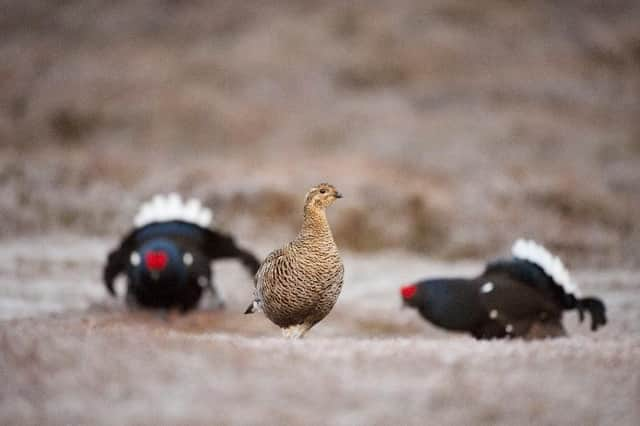Survey of rare birds on Angus estate shows 'encouraging' result


The Forestry and Land Scotland Environment Team and a group of volunteers recenlty counted the birds during their annual lek at Glenprosen to try to determine a baseline for the black grouse population on the site, as a reference point for future surveys.
The ‘lek’ – a spectacular mating display where male birds, known as blackcock, strut and posture with others while issuing a soft, bubbling call, often culminating in brief bursts of fighting - is acknowledged as the best way to gauge the number of breeding birds present.
Advertisement
Hide AdAdvertisement
Hide AdData collected over the two separate morning counts indicates around 40-45 males present, a healthy number for a species that is facing severe decline in Scotland.
Surveys focus on counting the male birds as they are easier to see – the females, known as greyhens, are well camouflaged.
Emily Platt, Environment Ranger with FLS, said: “For one site, we found a good number of black grouse, which is very encouraging. The species is on the endangered list, so monitoring is really important and now, with the purchase of Glenprosen, we want to make sure we can enhance and improve the habitat, managing it so that it benefits Black Grouse and other species in the future.
“This year was important to get that baseline recorded but ultimately, the work done so far is only a start and ongoing monitoring is essential.”
Advertisement
Hide AdAdvertisement
Hide AdThis year’s survey involved 19 volunteers in total, who camped out overnight in freezing conditions to be in place around an hour before sunrise, sitting quietly at a vantage point that is typically a kilometre or more away from the lek sites, so as not to disturb the birds.
Disturbance of black grouse and capercaillie during the lek is a serious concern: when they are displaying, the birds put in a lot of energy so it is important to be as unobtrusive as possible.
In recent years there have been increasing problems with photographers and birdwatchers getting too close to lekking sites and disturbing these endangered species. Earlier this month, FLS (Forestry and Land Scotland) launched a campaign - “Protect Scotland’s Wildlife” - urging people in Scotland to take extra care to safeguard wildlife and the environment, especially during breeding season.
If the black grouse is to thrive, more land needs to be managed on a large scale with its needs in mind. FLS is working with partners in various parts of Scotland to create grouse management plans to manage land sympathetically to meet the needs of the black grouse.
Advertisement
Hide AdAdvertisement
Hide AdEmily explained that managing forestry and woodland to promote the recovery of Black Grouse populations involves a careful balance.
She added: “Habitat-wise, black grouse need a mosaic of habitats including native woodland and heather moor fringes for resting and displaying, and shrubbier habitat such as blaeberry and rowan for feeding on their berries. Ultimately, it’s all about considering where and what to plant, and importantly where not to plant.”
FLS plan to repeat this survey next year and in future years.